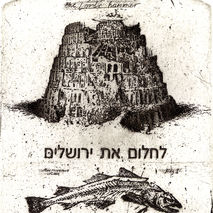Dreaming of Jerusalem
selected artwork 1996 - 2000
"exquisite and captivating"
"primal and profoundly evocative as if someone were playing a particularly resonant instrument"
To Dream of Jerusalem There was a loud bang. I was standing looking in the window of Steimatzki’s bookshop on Jaffa Road in central West Jerusalem and was about to walk in. Then all I saw was people scattering and pigeons taking flight. With the realisation that it wasn’t a bomb, but only a car back firing, life resumed its usual hectic pace and I walked off. Later, a colleague of mine from the Jerusalem Print Workshop (JPW) would not be so lucky. That was in 1996 when I was first invited to work at the Jerusalem Print Workshop for a month as part of the Glasgow Print Studio’s international exchange program. Since then, all of my work has been concerned with the city of Jerusalem and with the burden of historical and contemporary baggage that it bears. Unexpectedly, this followed on from previous work I made whilst resident at the Senej Print Workshop near Moscow in 1992, work which was informed by the legacy left behind by the collapse of communism in the USSR, Eastern Europe and the Balkans. For many, Jerusalem is the closest that one can get to the Divine of one’s own accord. But nowhere more than in the Holy City did I experience our separation from the Divine in the most painfully obvious way. In Jerusalem, my own sense of the loss of Eden, of a loss or a searching that still lies deep within the make up of each one of us, was brought sharply into focus. Here, I also became intrigued by the principles in ancient map making. The more important a place is, the larger and the closer to the centre of the map it appears. The same approach was adopted by the icon painters in the Byzantine and Renaissance eras. Geographical reality is less of a consideration than spiritual significance. In this sacred science, Jerusalem has often been portrayed as the centre of the world (a geographical and meteorological reality that may be closer to actual fact than we realise). In the ancient world, the establishment of a sacred site was initiated by the presence of, or an event associated with the Divine. It was of supreme importance in establishing a contact with Heaven. Jerusalem was established on such a site. The rock under the golden dome of the Qubbat al Sakhra on what is also known as the Temple Mount is the ancient sacrificial alter of Abraham of Biblical Mount Moriah. It was known as a sacred site at the time of Jerusalem’s first founding, and as the city grew up around it, it became the site of Solomon’s temple. Later, among the ruins of the Temple, it was the rock from which Muslims believe Mohammed ascended to Heaven to receive further instruction from Allah. For me, the welfare of Jerusalem, represented by the old wood engravings used in my artworks, has become an indicator of the welfare of our own humanity, not only as individuals but collectively, globally as a society. Jerusalem has prospered in the past at times when religious tolerance and social justice have prevailed. In Jerusalem I saw only too clearly that once again we have lost sight of Eden. But it is not a loss without the hope of returning. So I still dream of Jerusalem. This essay (since revised and edited) was published in Printmaking Today, Volume 10 Issue 3, © Cello Press and is used here with kind permission.













